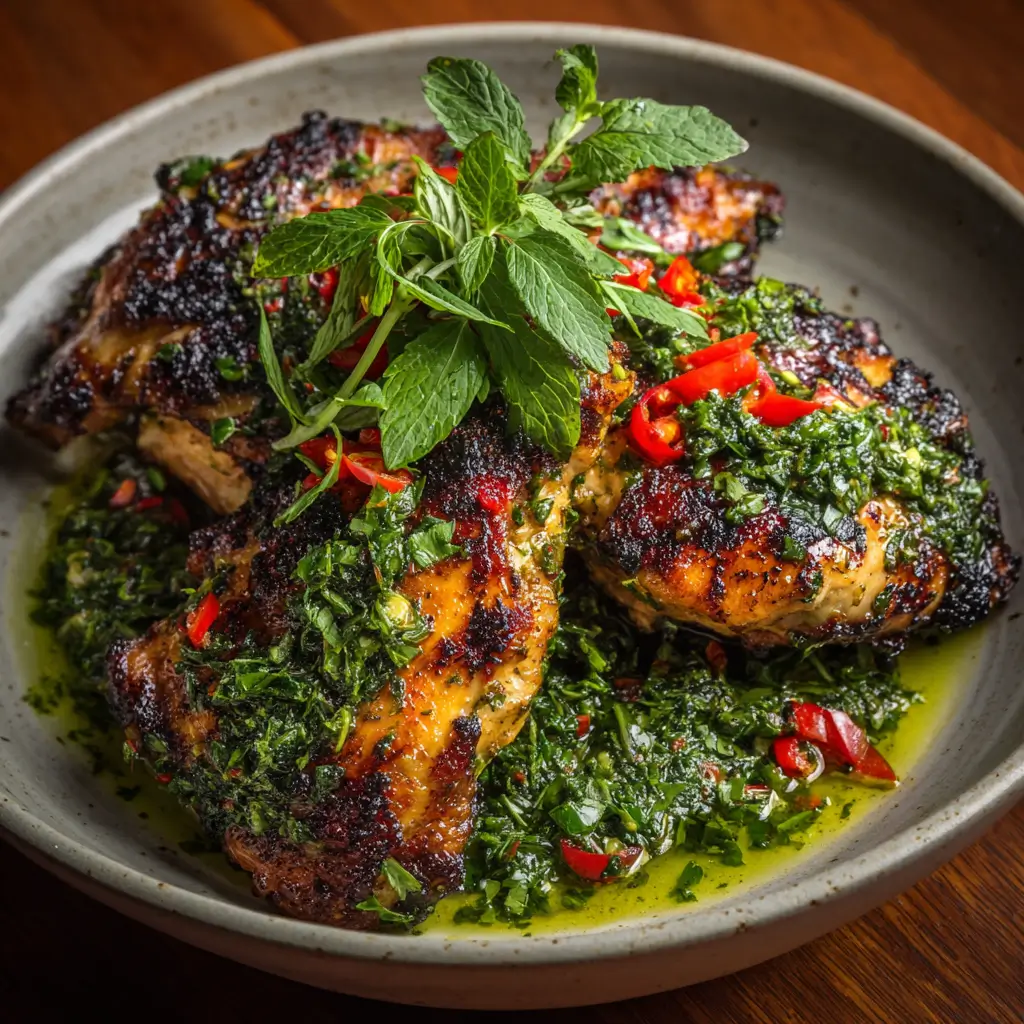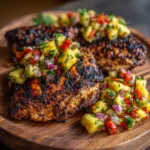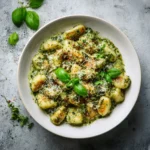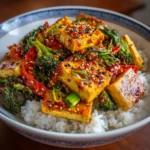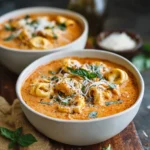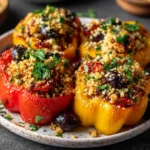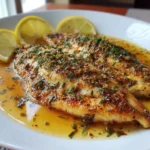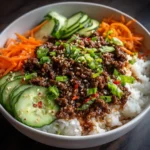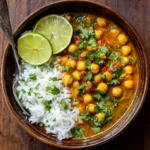Grilled Chimichurri Chicken: A Flavorful South American Delight
If you’re looking for a dish that bursts with vibrant flavors, smoky char, and herbaceous freshness, then Grilled Chimichurri Chicken is exactly what you need. This mouthwatering recipe combines the bold traditions of Argentinean cuisine with the simplicity of home grilling, resulting in a meal that’s perfect for weeknight dinners or weekend entertaining. Whether you’re hosting a backyard barbecue or simply craving something deliciously different, this grilled chicken infused with chimichurri sauce delivers on every level—aroma, taste, texture, and presentation.
The History of Chimichurri and Its Culinary Journey
Chimichurri is a traditional sauce originating from Argentina and Uruguay, deeply rooted in the rich gaucho (cowboy) culture of the Pampas region. While its exact origins are debated, many believe the name may have evolved from a Spanish adaptation of the Basque word “tximitxurri,” meaning “a mixture of several things in no particular order.” Others suggest it was named after an Irish soldier named Jimmy McCurry, who supposedly used a similar sauce while stationed in South America during the 19th century.
Originally created as a way to enhance the flavor of grilled meats—especially beef—chimichurri quickly became a staple across South American parrillas (barbecues). The sauce’s bright acidity cuts through the richness of fatty cuts, balancing the palate and elevating the entire dining experience. Over time, its popularity spread globally, inspiring chefs and home cooks alike to pair it with various proteins, including fish, vegetables, and poultry.
While traditionally served with steak, using chimichurri as a marinade and finishing sauce for grilled chicken has become increasingly popular due to its ability to tenderize the meat while infusing it with layers of fresh, zesty flavor. Today, Grilled Chimichurri Chicken stands as a modern fusion classic—honoring tradition while embracing versatility and global tastes.
Ingredients Breakdown: What Makes Chimichurri So Special?
The magic of chimichurri lies in its balance of ingredients—each playing a crucial role in building depth, brightness, and complexity. Let’s break down the components:
- Fresh Parsley: The backbone of the sauce, flat-leaf parsley provides a grassy, slightly peppery base. It should be finely chopped but not puréed to retain texture.
- Garlic: Raw garlic adds pungency and aromatic intensity. Use freshly minced cloves for maximum impact; pre-minced jarred garlic lacks the same vibrancy.
- Olive Oil: High-quality extra virgin olive oil acts as the carrier, emulsifying the herbs and spices while adding fruitiness and smooth mouthfeel.
- Red Wine Vinegar: This gives chimichurri its signature tang. Its acidity brightens the sauce and helps preserve freshness when stored.
- Red Pepper Flakes: For heat and subtle smokiness. Adjust according to spice tolerance—some versions use fresh jalapeño or even smoked paprika.
- Oregano: Dried oregano is preferred here because it concentrates flavor better than fresh. It adds earthy, slightly floral notes reminiscent of Mediterranean cuisine.
- Lemon Zest (Optional): Some variations include lemon zest to amplify citrus undertones without making the sauce too tart.
- Onion or Shallot (Optional): Finely diced red onion or shallot can add mild sharpness and crunch, enhancing both flavor and texture.
When combined, these ingredients create a harmonious blend that’s simultaneously herb-forward, garlicky, tangy, and mildly spicy—a perfect complement to grilled chicken.
Step-by-Step Recipe: How to Make Perfect Grilled Chimichurri Chicken
Follow this detailed guide to achieve juicy, flavorful Grilled Chimichurri Chicken every time.
Ingredients
For the Chimichurri Sauce:
- 1 cup packed fresh flat-leaf parsley, finely chopped
- 4 cloves garlic, minced
- 1/2 cup extra-virgin olive oil
- 3 tablespoons red wine vinegar
- 1 teaspoon dried oregano
- 1/2 teaspoon red pepper flakes (adjust to taste)
- 1 teaspoon kosher salt
- 1/2 teaspoon freshly ground black pepper
- 1 tablespoon fresh lemon juice (optional)
- Zest of 1/2 lemon (optional)
- 2 tablespoons finely diced red onion or shallot (optional)
For the Chicken:
- 4 boneless, skinless chicken breasts (about 6 oz each), or thighs for juicier results
- 1 tablespoon olive oil (for brushing)
- Salt and pepper to taste
- Wood chips (optional, for added smokiness if using gas grill)
Directions
- Prepare the Chimichurri Sauce: In a medium bowl, combine the chopped parsley, minced garlic, red wine vinegar, dried oregano, red pepper flakes, salt, and black pepper. Slowly whisk in the olive oil until well blended. Stir in optional ingredients like lemon juice, zest, and red onion if desired. Cover and let the sauce sit at room temperature for at least 30 minutes to allow flavors to meld. Alternatively, refrigerate for up to 2 hours and bring back to room temperature before serving.
- Marinate the Chicken: Place the chicken breasts in a resealable plastic bag or shallow dish. Pour about half of the prepared chimichurri sauce over the chicken, reserving the other half for serving. Seal or cover and marinate in the refrigerator for at least 1 hour, preferably 4–6 hours (but no more than 8 hours, as the acidity can begin to break down the proteins too much).
- Preheat the Grill: Preheat your grill to medium-high heat (around 375°F–400°F). Clean the grates thoroughly and lightly oil them to prevent sticking. If using a gas grill and wanting a smoky flavor, soak wood chips (such as hickory, cherry, or oak) in water for 30 minutes, then place in a smoker box or aluminum foil pouch with holes poked in it.
- Bring Chicken to Room Temperature: Remove the chicken from the refrigerator 20–30 minutes before grilling to ensure even cooking.
- Grill the Chicken: Take the chicken out of the marinade, letting excess drip off. Discard the used marinade. Lightly brush the chicken with a small amount of olive oil and season both sides with salt and pepper. Place the chicken on the hot grill. Cook for 6–7 minutes per side, depending on thickness, until the internal temperature reaches 165°F when measured with a meat thermometer inserted into the thickest part.
- Avoid Overcooking: To keep the chicken moist, avoid pressing down on it with a spatula, which forces out juices. Flip only once. If flare-ups occur, move the chicken to a cooler zone temporarily.
- Rest the Chicken: Once cooked, transfer the chicken to a clean plate and tent loosely with foil. Let rest for 5–7 minutes. This allows the juices to redistribute throughout the meat, ensuring tenderness and moisture.
- Serve with Fresh Chimichurri: Slice the chicken against the grain or serve whole, drizzling generously with the reserved fresh chimichurri sauce just before serving. Garnish with extra parsley or a wedge of lemon if desired.
Tips for Success
- Use Fresh Herbs: Always go for fresh, vibrant parsley. Wilted or yellowing herbs will dull the sauce’s flavor.
- Don’t Over-Chop: While food processors make quick work of chopping, pulsing too long turns chimichurri into a paste. Hand-chopping preserves texture and authenticity.
- Balance Acidity: Taste your chimichurri before using. If it’s too acidic, add a touch more olive oil. Too oily? Add a splash of vinegar.
- Marinating Time Matters: Marinate chicken for at least 1 hour, but don’t exceed 8 hours. Prolonged exposure to acid can make the exterior mushy.
- Uniform Thickness: Pound thicker chicken breasts gently between plastic wrap to an even ¾-inch thickness for consistent cooking.
- Check Temperature: Invest in a reliable instant-read thermometer. Overcooked chicken dries out fast—pull it at 160°F; carryover cooking will take it to 165°F.
- Double the Sauce: Chimichurri keeps well and tastes better the next day. Make extra to use on roasted vegetables, eggs, sandwiches, or grilled fish.
- Grill Marks = Flavor: Get those beautiful sear marks by placing chicken at a 45-degree angle to the grates and not moving it until ready to flip.
Variations and Customizations
One of the best things about Grilled Chimichurri Chicken is how easily it adapts to personal preferences and dietary needs. Here are some creative twists:
- Green vs. Red Chimichurri: Traditional green chimichurri uses parsley. Try a red version by replacing half the parsley with fresh cilantro and adding 1–2 roasted red peppers or a tablespoon of tomato paste for sweetness and color.
- Cilantro-Lime Twist: Swap half the parsley with fresh cilantro and replace red wine vinegar with lime juice for a Mexican-inspired profile.
- Smoky Chimichurri: Add 1/2 teaspoon smoked paprika or a few drops of liquid smoke to the sauce for a deeper, campfire-like aroma.
- Dairy-Free & Vegan Friendly: The recipe is naturally dairy-free and vegan (except for the chicken). Serve the sauce over grilled tofu, portobello mushrooms, or cauliflower steaks.
- Low-Sodium Option: Reduce or omit added salt and use low-sodium vinegar. Boost flavor with extra garlic and herbs instead.
- Spicy Kick: Add one finely minced serrano or jalapeño pepper (seeds removed for milder heat) to the chimichurri for extra fire.
- Fruit-Infused: Add 1 tablespoon of finely diced mango or pineapple to the sauce for a sweet-tart contrast that pairs beautifully with grilled chicken.
- Herb Variations: Mix in fresh oregano, mint, or basil for unique herbal nuances.
- Cooking Method Alternatives: No grill? Use a grill pan indoors, broil in the oven (watch closely!), or pan-sear on the stovetop for similar caramelization.
Health Considerations and Nutritional Value
Grilled Chimichurri Chicken isn’t just delicious—it’s also a nutritious choice for health-conscious eaters.
- Lean Protein Source: Chicken breast is low in fat and high in protein, supporting muscle maintenance and satiety.
- Heart-Healthy Fats: Extra virgin olive oil contains monounsaturated fats and antioxidants linked to reduced inflammation and improved cardiovascular health.
- Antioxidant-Rich Herbs: Parsley is rich in vitamin K, C, and flavonoids. Garlic supports immune function and may help lower blood pressure.
- Low Carb & Keto-Friendly: Naturally low in carbohydrates, this dish fits well within ketogenic, paleo, and gluten-free diets.
- Digestive Benefits: Vinegar aids digestion and may help regulate blood sugar levels when consumed with meals.
Nutritional Estimate (per serving – 1 chicken breast + 2 tbsp chimichurri):
- Calories: ~290
- Protein: 35g
- Fat: 14g (mostly unsaturated)
- Carbohydrates: 3g
- Fiber: 1g
- Sodium: 500mg (varies based on salt used)
- Vitamin C: 20% DV
- Vitamin K: 120% DV
- Iron: 10% DV
Pair with quinoa, brown rice, or a fresh salad to boost fiber and nutrients. Limit sodium by adjusting salt content and choosing lower-sodium ingredients.
Frequently Asked Questions (FAQ)
Q: Can I make chimichurri ahead of time?
A: Absolutely! Chimichurri actually improves after sitting for a few hours or overnight. Store in an airtight container in the fridge for up to 1 week. Bring to room temperature before serving.
Q: Can I freeze chimichurri?
A: Yes, though texture may change slightly upon thawing. Freeze in ice cube trays, then transfer cubes to a freezer bag. Use within 3 months. Thaw in the fridge and stir well before using.
Q: Is chimichurri spicy?
A: Not inherently. The heat comes from red pepper flakes, which can be adjusted or omitted entirely. It’s more tangy and herbaceous than hot.
Q: Can I use dried parsley?
A: No. Dried parsley lacks the vibrant flavor and texture needed for authentic chimichurri. Fresh is essential.
Q: What sides go well with grilled chimichurri chicken?
A: Excellent pairings include grilled vegetables, chimichurri potatoes, couscous, arugula salad with shaved Parmesan, corn on the cob, or avocado slices.
Q: Why did my chicken turn out dry?
A: Most likely overcooked. Use a thermometer and remove chicken at 160°F. Also, marinating longer than 8 hours in acidic sauce can toughen the meat.
Q: Can I bake the chicken instead of grilling?
A: Yes. Bake at 400°F for 20–25 minutes or until 165°F internally. Broil for 2–3 minutes at the end for browning. Baste with chimichurri halfway through.
Q: Is chimichurri the same as pesto?
A: While both are herb-based sauces, they differ significantly. Pesto typically includes nuts, cheese (like Parmesan), and basil, whereas chimichurri relies on parsley, vinegar, garlic, and olive oil with no dairy or nuts.
Summary
Grilled Chimichurri Chicken brings together the bold, zesty flavors of Argentina with the ease of modern grilling, creating a dish that’s both exciting and approachable. With its vibrant herb sauce, juicy grilled meat, and endless customization options, it’s sure to become a favorite in your recipe rotation.
